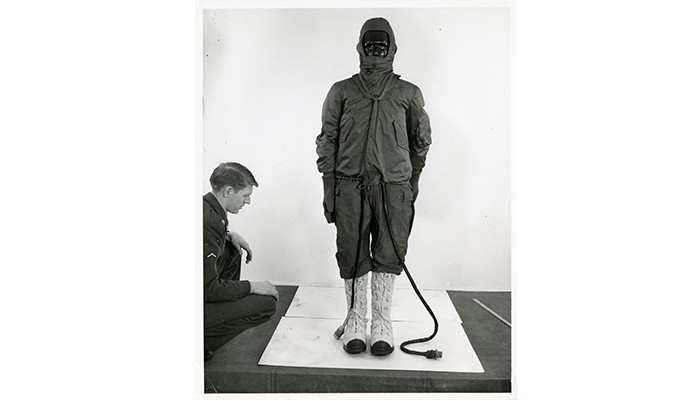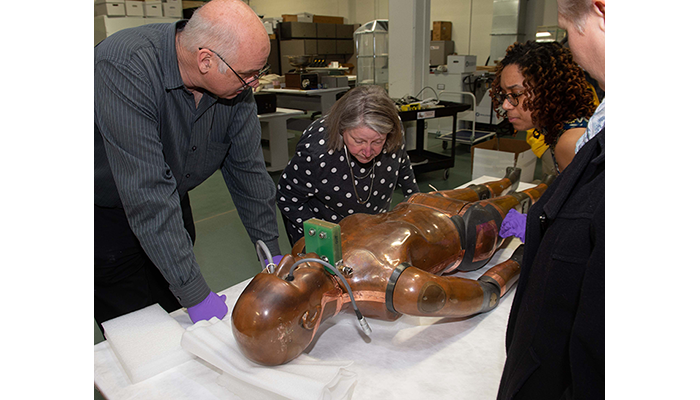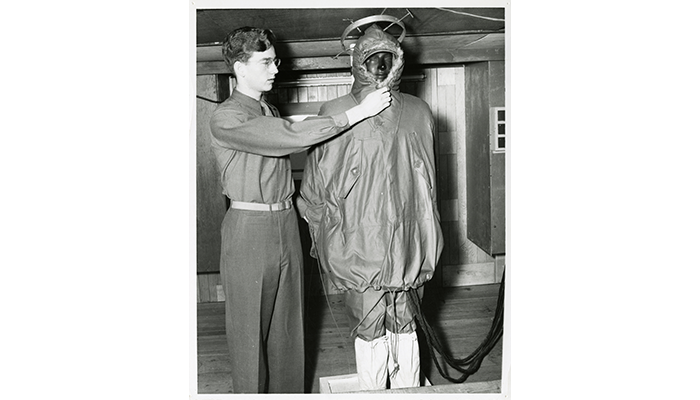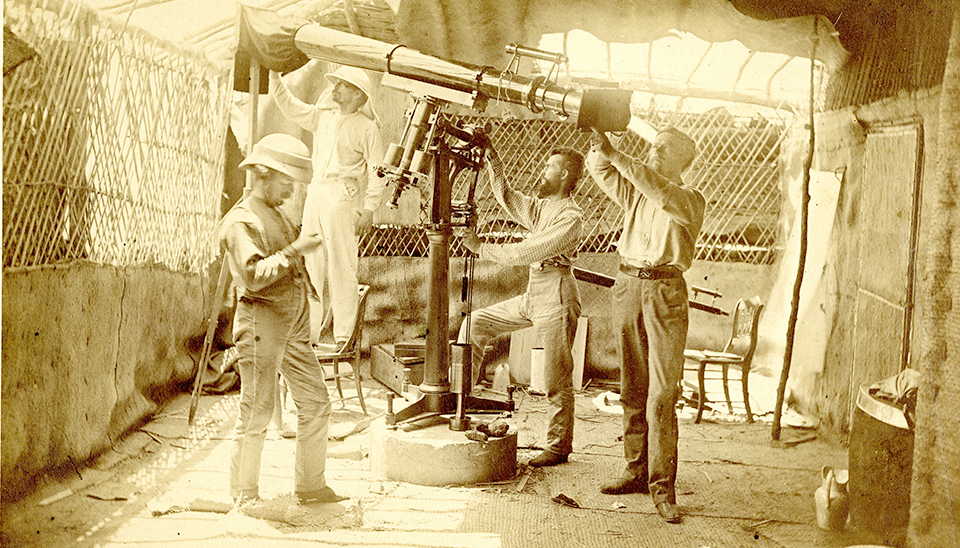The U.S. Army Research Institute of Environmental Medicine (USARIEM) in Natick, Massachusetts has transferred a full-body thermal test manikin to the National Museum of Health and Medicine's (NMHM) permanent collection. Named Uncle Wiggly by its manufacturer, Arthur D. Little, Inc., it was delivered to USARIEM in 1984. Manikins like Uncle Wiggly played an important role in testing the performance of clothing used by our warfighters under a variety of environmental conditions.
Uncle Wiggly is a copper, full-body manikin used to measure the effects of motion on heat loss from a clothed figure. It is a walking manikin that is articulated to allow the arms and legs to swing back and forth in a linear plane to simulate motion. It has 18 heat measurement zones, a control panel, and aluminum joints. Uncle Wiggly could be fitted with a cotton or polyester wicking skin, and had multiple thermal control points to control temperature.

Chauncey testing winter coat, pants, and boots, U.S. Army Quartermaster Research Command, Climactic Research Laboratory, Lawrence, Mass., 1947. (NMHM, OHA 329.8, Chauncey 003)
Manikins were critical to USARIEM's clothing research because they provided a platform to test different kinds of clothing in a controlled environment. Full-body manikins measured two clothing properties: resistance to heat transfer (insulation) and permeability to water vapor (water resistance). Controlling manikin temperature and moisture and exposure to certain environmental conditions allowed replicable test data. This information was used to select the most appropriate clothing for the environmental conditions a warfighter faced. To the experience of a service member, this could mean the difference between staying dry, being dangerously wet, or becoming much too cold. Researchers could test individual pieces of clothing or whole ensembles to measure the impact and effects of multiple layers, fit, insulation space, impact of adding or changing layers, and types of clothing.
Having the right weapons, vehicles, and equipment, including clothing, are essential for today's service members to accomplish their mission. Clothing provides basic protection to the body from temperature, elements, bugs and plants, and even from certain kinds of chemical and biological agents. Factors, such as durability, cost, camouflage, weight, fit, and comfort, are all considered in outfitting today's warfighter. Selecting the best clothing for a given environment can be critical to survival, and research conducted by USARIEM using full-body test manikins provides information necessary to the decision making process.

National Museum of Health and Medicine (NMHM) staff (from left to right: Historical Collections Manager Alan Hawk, Director Dr. Adrianne Noe, Historical Collections Assistant Camille Bethune-Brown, and Executive Administrator Karen Kelly) study test manikin Uncle Wiggly. [NMHM 2019.0002.1] (Disclosure: This image has been cropped to emphasize the subject.) (190228-D-MP902-3033: Department of Defense photo by Matthew Breitbart/ Released)
The use of manikins to test clothing began in the 1940s. Full-body manikins evolved from crude forms hardly resembling the human body to distinct three-dimensional body reproductions like Uncle Wiggly. Improvements in methods to distribute heat and moisture through the manikins led to more realistic forms and test results. Researchers created specific form models of feet, hands, and heads to test the corresponding thermal properties.
USARIEM used full-body manikins to test military issued clothes, commercial off-the-shelf clothing, and prototype clothing for both the military and other government agencies, as well as professionals like firefighters and police. Tests using the manikins were often performed prior to or in conjunction with human subject field testing. Human testing, while an essential part of the clothing research process, could be expensive, was time consuming, involved fewer sensors, and could provide less accurate results. Unlike human testing, manikin testing allowed researchers to control the conditions of the experiment and perform certain tests that could place a human subject at risk.

Chauncey testing cold weather ensemble, U.S. Army Quartermaster Research Command, Climactic Research Laboratory, Lawrence, Mass., 1947. (NMHM, OHA 329.8, Chauncey 004)
Uncle Wiggly is the second full-body manikin in NMHM's collection. It joins Chauncey, an earlier generation copper manikin manufactured by General Electric in the 1940s. Chauncey's notable differences include its black-finished surface, non-movable limbs, and lack of zone temperature control. Both manikins and foot, hand, and head models in the museum's collection document significant advances in thermal and clothing research and how the military measured the physiological effects of hot and cold on the human body.
Resources
Check out other Advances in Military Medicine on exhibit at NMHM.




